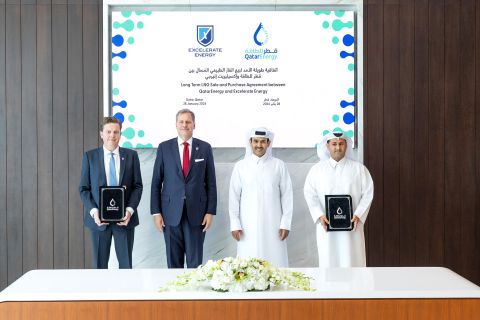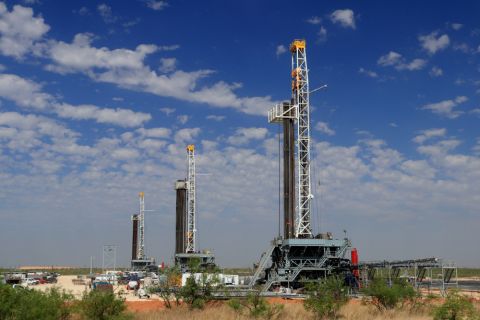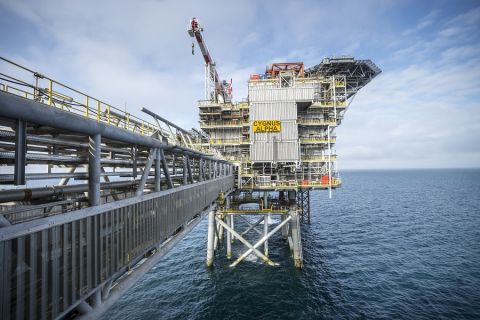Companies seeking to build and strengthen the hydrogen market were busy this week awarding contracts, making plans to boost production and advancing projects.
This week, Exxon Mobil announced it has selected Technip Energies to carry out engineering and design work for its massive hydrogen plant. Targeting production of 1 Bcf/d of low-carbon hydrogen, Exxon Mobil plans to build the hydrogen, ammonia and carbon capture facility in Baytown, Texas, where it will be paired with the company’s olefins plant. It aims to capture and permanently store about 7 million metric tons (MMmt) of CO2 annually.
Pending a final investment decision (FID), which is expected by 2024, and other conditions, the facility could start up in 2027 or 2028.
In California, green hydrogen producer Linde Plc said growing demand from the mobility market has prompted the company to increase production.
More partnerships also formed with EDP Renewables and Cepsa, saying they will work together to develop an up to 1 gigawatt (GW) hydrogen project in Spain.
Here’s a look at some of this week’s renewable energy news.
Hydrogen
SGH2’s ‘Greener-Than-Green’ Hydrogen Plant Gets Green Light
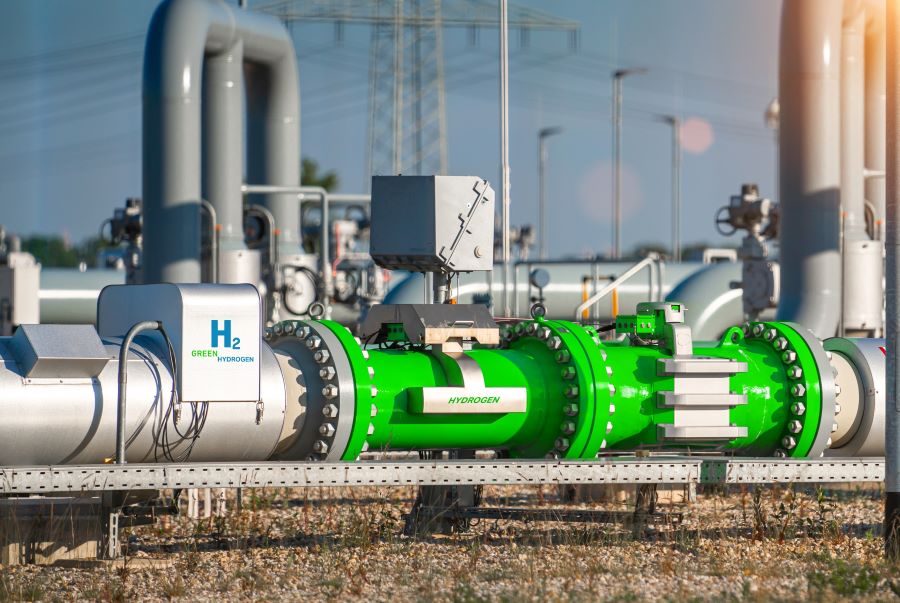
SGH2 Energy Global Corp. has taken a FID on its carbon-negative hydrogen production facility after its use permit and environmental impact statement were approved by regulators in Lancaster, Calif.
The company said Feb. 2 it passed the final hurdle with the Lancaster Planning Commission, clearing the project’s FID and engineering, procurement and construction phase. The approval qualifies it to receive a $3 million grant awarded by the California Energy Commission (CEC).
The project also qualifies for a clean hydrogen production tax credit in the Inflation Reduction Act, it said.
“Not only are we producing more hydrogen with a larger negative carbon footprint than other proposed green hydrogen projects, but we have now cleared a steep hurdle that no other large-scale green hydrogen company has achieved,” said GH2 CEO Dr. Robert T. Do.
The plant will feature SGH2’s Solena Plasma Enhanced Gasification technology, which converts rejected recycled mixed-paper waste to clean hydrogen that is carbon negative, the company said in a news release.
About 42,000 tons per year of rejected recycled mixed-paper waste will be used to produce up to 12,000 km/d of clean hydrogen, enough to fuel over 2,000 fuel cell electric cars or 350 fuel cell buses or trucks per day, the company said.
“All the carbon-negative clean hydrogen we produce has long-term off-take agreements and will supply hydrogen refueling stations in the Los Angeles metropolitan areas while simultaneously supporting the [CEC’s] and the Air Resources Board’s goal of decarbonizing our heavy mobility footprint,” Do said.
Eneos Opens Green Hydrogen Test Plant in Australia
Eneos Corp., Japan’s biggest oil refiner, on Feb. 1 opened a small green hydrogen plant in Australia which will demonstrate its patented electrolysis technology, the Queensland state government said.
Backed by the Japanese government’s 2 trillion yen ($15 billion) Green Innovation Fund, Eneos will be able to make 20 km/d of green hydrogen, using its Direct MCH technology powered by a solar system on site, the state said.
“This project is set to unlock significant benefits for Queensland's economy by generating hydrogen jobs of the future and tapping into new export markets,” the state's deputy premier, Steven Miles, said in a statement.
Eneos says on its website that its technology is low-cost and efficient as it stores hydrogen as a liquid in the form of methylcyclohexane (MCH) made from water, toluene and renewable energy in a single step, without having to produce hydrogen as a gas first.
By storing green hydrogen as MCH rather than as liquid hydrogen, the product can be handled using existing petroleum infrastructure, rather than having to chill the hydrogen to -253 C (-487 F) to be able to transport it.
Air Liquide, TotalEnergies Make Plans for Hydrogen Stations
Air Liquide and TotalEnergies will work together to develop a network of 100 hydrogen stations along major roads in Europe, the companies said Feb. 2.
As part of the joint venture, the companies said they will invest, build and operate the stations and procure hydrogen from the market for its customers.
“Air Liquide will contribute with its expertise in technologies and its mastery of the entire hydrogen value chain,” while “TotalEnergies will bring its expertise in the operation and management of stations networks and the distribution of energies to B-to-B customers,” the release stated.
The companies plan to set up the joint venture this year.
Rising Demand Prompts Linde to Boost Production
Green hydrogen producer Linde Plc said Jan. 31 it will increase production in Ontario, Calif., due to growing demand from the mobility market.
The Ireland-based company said it will build, own and operate a 5-megawatt (MW) proton
exchange membrane electrolyzer to increase its hydrogen capacity. Several more are being planned by Linde for the U.S.
The first new electrolyzer is expected start up in second-half 2024.
“We continue to see growing demand for green hydrogen as decarbonization in the mobility sector becomes a reality,” said Marcos Cuevas, vice president of Linde’s West Region. “As the largest liquid hydrogen producer in the U.S., we are proud to leverage our technology and expertise to help California achieve its ambitious climate goals.”
Johnson Matthey Partners with Plug Power to Boost Hydrogen Tech
Johnson Matthey said on Jan. 31 it was partnering in hydrogen technology with U.S.-based Plug Power until at least 2030, as the British company hones its focus on its green hydrogen-related business.
Johnson Matthey is a supplier of catalyst coated membranes (CCMs), which are a key component of fuel cells that use hydrogen fuel to generate electricity.
The London-based firm said it would supply a substantial portion of Plug’s demand for components of fuel cells and electrolyzers, to be used for green hydrogen production.
“The rationale for the partnership is driven by the push towards renewable energy, largely due to the regulatory incentives provided in the United States and partly due to the energy crisis in Europe,” Johnson Matthey CEO Liam Condon told Reuters.
The FTSE 100 firm, which makes catalytic converters for vehicles and refines the platinum group of metals used mainly by automakers, said last year it was exiting its battery materials business due to tough competition and low returns.
It is targeting $246 million (~203 million pounds) in sales from its hydrogen technology business by 2025, compared with just 25 million pounds last year, and expects “significant sales growth” thereafter.
Johnson Matthey said the companies would jointly invest in up to 10 GW of new CCM manufacturing capacity in the United States, which would begin production in 2025. The company did not disclose specific financial details about the partnership.
EDP, Cepsa Partner for Green Hydrogen Production
Portugal-headquartered EDP Renewables is teaming up with Spanish oil company Cepsa to develop green hydrogen in Spain, EDP said in a Jan. 30 news release.
The alliance for the up to 1 GW hydrogen project in Campo de Gibraltar was reached as both companies seek to decarbonize and produce sustainable marine fuels. As a partner in what Cepsa said is its largest green hydrogen project in Europe, EDP will provide electricity needed to produce green hydrogen, the release stated.
“This agreement with CEPSA is an important milestone for the conversion of EDP's thermal power plant in Los Barrios and to promote industrial decarbonization through green hydrogen, being another step to strengthen the energy independence in Europe,” EDP CEO Miguel Stilwell d’Andrade said.
Honda to Produce New Hydrogen Fuel Cell System Co-developed with GM
Japan’s Honda Motor Co. said it will start producing a new hydrogen fuel cell system jointly developed with General Motors Co. this year and gradually step up sales this decade, in a bid to expand its hydrogen business.
Honda will target annual sales of around 2,000 units of the new system in the middle of this decade, the company said on Feb. 2, aiming to boost that to 60,000 units per year in 2030.
The Japanese carmaker is seeking to expand the use of its new system not only for its own fuel cell electric vehicles but also commercial vehicles such as heavy trucks, as stationary power stations and in construction machinery.
Honda will start production of the hydrogen fuel cell system through its joint venture with GM this year, Honda senior managing executive director Shinji Aoyama told reporters during a company event in Tokyo.
Solar
TotalEnergies Cranks Up Tsu Power Plant in Japan
TotalEnergies said Feb. 1 it has started commercial operations at its 51-MW Haze solar power plant located in Tsu, Mie Prefecture, Japan, marking the company’s fourth large-scale solar plant in the country.
With nearly 100,000 high-efficiency solar panels, the power plant covers about 190 acres (77 hectares) and is designed to provide enough to about 20,000 households, TotalEnergies said in a news release.
“With more than 150 MW of cumulative capacity in operation, we are proud to contribute to the country’s energy transition,” said Vincent Stoquart, senior vice president of renewables for TotalEnergies.
Electricity produced at the plant will go to Chubu Electric Power Miraiz Co. Inc., which signed a 17-year power purchase agreement.
The startup also moves TotalEnergies closer toward its goal of reaching 35 GW of gross production capacity from renewable sources and storage by 2025 and 100 GW by 2030.
WEC to Acquire Majority Stake in Samson I Solar
Milwaukee-based WEC Energy Group plans to acquire an 80% stake in the 250-MW Samson I Solar Energy Center for about $250 million, the company said Jan. 31.
Located about 140 miles northeast of Dallas, the Invenergy-built solar center is part of a 1,300-MW, five-phase development being constructed on 18,000 acres. Samson I was completed in May 2022 and has operated under a long-term power purchase agreement (PPA) with AT&T, according to a news release.
“The Samson Solar project is an exciting addition to our Infrastructure business and highlights our continued investment in affordable, reliable and clean energy,” said Gale Klappa, executive chairman for WEC. “This project will help one of the world's largest telecommunications companies meet their clean energy needs for years to come.”
Engie Lines Up CEE Group, Digital Realty PPA
Engie has inked a 10-year PPA with data center provider Digital Realty, expanding the energy company’s presence in Germany.
As part of the agreement, Digital Realty will have a 116-MW share of a new 154-MW ground mounted solar photovoltaic project being built by CEE Group in northeast of Germany, according to a Feb. 2 news release.
Engie, which served as the interface between the two companies, designed the PPA.
“This project will further improve the quality and impact of our renewable portfolio by reducing our reliance on existing renewable resources and supplanting them with Guarantees of Origin from this new solar park,” said Volker Ludwig, managing director, Germany, for Digital Realty.
Solar park operations are scheduled to begin in late 2023.
Enphase Energy Sees Growing Solar Demand in Brazil
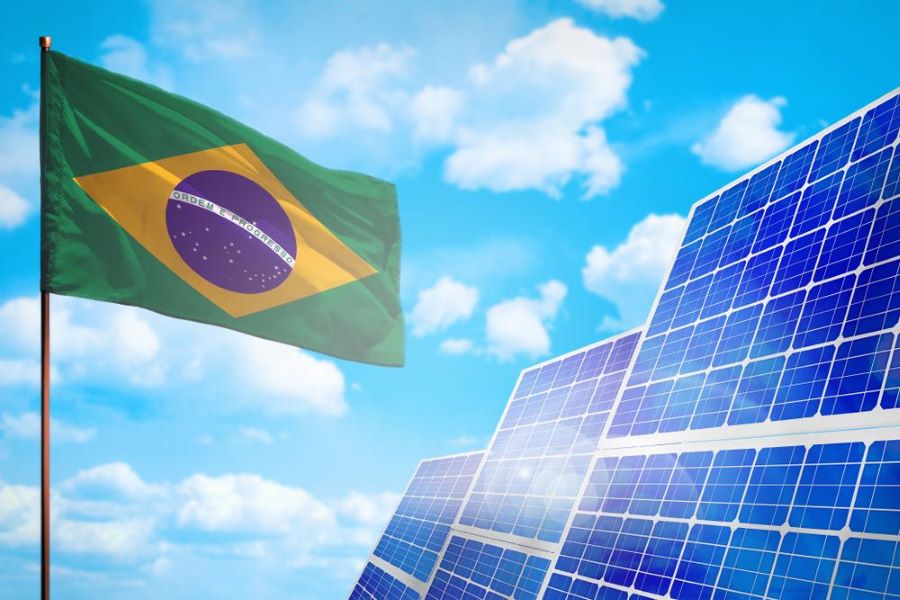
Enphase Energy Inc., supplier of microinverter-based solar and battery systems, has seen an uptick in Brazil of residential solar energy systems using the company’s IQ7+ and IQ7AM microinverter technology, Enphase said in a press release on Jan. 30.
In 2023, Brazil is expected to increase its solar generation capacity up more than 10 GW, a 52% increase of the country’s current solar generation capacity, according to the Brazilian Association of Photovoltaic Solar Energy in the press release.
“Since our introduction into the Brazilian market in 2021, we have grown our installer base to more than 500 – a testament to the rapidly growing demand for clean energy solutions in the country,” said Marco Krapels, Enphase Energy’s vice president of international sales.
Residential homeowners in Brazil are increasingly becoming a bigger target market as they “[look] to save on electricity costs and minimize their environmental footprint,” said Murilo Vidigal, project director at Mavo Engenharia, an installer of Enphase products.
Based in California, Enphase’s microinverter technology harnesses energy from the sun for clients using all-in-one solar, battery and software solutions to make, use, save and sell power using a mobile monitoring app.
The microinverter systems use a system called IG Gateway to connect an Enphase-based solar system to the Enphase app to monitor energy generation and consumption per panel. Customers can use data tracked in their app to oversee insights, operations and system maintenance, as well as better understand energy bills.
Wind
Marubeni Starts Commercial Operation at Akita Offshore Wind Farm
Japanese trading firm Marubeni Corp. started commercial operations based on the feed-in tariff program for renewable energy at Akita Port offshore wind farm on Jan. 31, it said in a statement.
Japan’s offshore wind power market, part of the country's goal to be carbon neutral by 2050, is set to grow as the government eyes installing up to 10 GW of offshore wind capacity by 2030, and up to 45 GW by 2040.
Marubeni’s $768 million project of two wind farms with 140-MW capacity at Akita Port and Noshiro Port in northern Akita prefecture is Japan's first large-scale commercial offshore wind power project.
With its Noshiro Port offshore wind farm operating since late December last year, the launch of the Akita Port farm brings the project to the full-scale operation, Marubeni said.
Power from the two wind farms will be sold to Tohoku Electric Power for 20 years under a PPA based on the feed-in tariff program.
Marubeni's 12 partners include Obayashi Corp., Tohoku Sustainable & Renewable Energy Co., Cosmo Eco Power Co., Kansai Electric Power Co. and Chubu Electric Power Co.
Oceaneering, Kontiki Partner to Electrify Offshore Assets
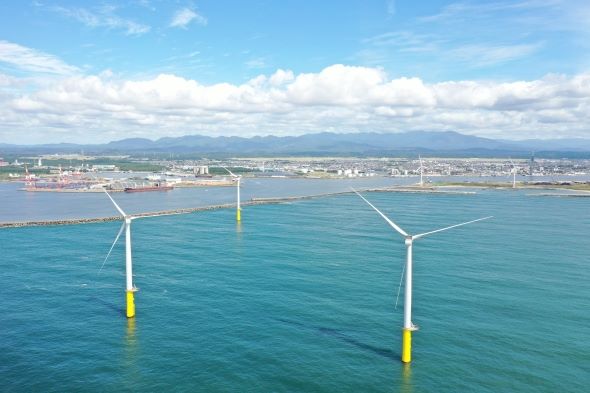
Oceaneering International and Havfram’s Kontiki Winds have agreed to jointly pursue opportunities to electrify offshore assets using floating offshore wind for microgrid renewable power generation, according to a Jan. 30 news release.
Efforts will focus on Brazil, the Gulf of Mexico and northern Europe.
Oceaneering and Kontiki, an offshore wind development and subsea construction specialist, intend to “provide a comprehensive and cost competitive approach to electrification using offshore wind to realize microgrid electrification.”
“This collaboration supports the transformation from traditional oil and gas development into next-generation floating offshore wind,” said Ben Hooker, director of global business development at Oceaneering. “It not only aligns our shared common values and uncompromising commitment to health, safety and the environment, but also propels our core capabilities, technology, innovation and operational excellence into the areas of emission reduction, energy transition and microgrid electrification in harsh environments.”
OX2 Starts Work at Tyrsky Wind Far in Gulf of Bothnia
Sweden-headquartered OX2 said it has started work toward developing the 1,400-MW Tyrsky offshore wind farm in Finland’s Gulf of Bothnia, having secured a research permit last year.
Next steps for the project, which will have about 100 turbines with an annual production of about 6 TWh, include carrying out an environmental impact assessment, the company said.
“The great shift towards hydrogen, fossil-free industries and general electrification demands huge amounts of renewable energy,” said OX2 CEO Paul Stormoen. “Offshore wind farms are the fastest and most cost-effective way to build large-scale electricity production.”
Plans are for operations to begin around 2030, the company said.
Hart Energy staff and Reuters contributed to this article.
Recommended Reading
Excelerate Energy, Qatar Sign 15-year LNG Agreement
2024-01-29 - Excelerate agreed to purchase up to 1 million tonnes per anumm of LNG in Bangladesh from QatarEnergy.
UK’s Union Jack Oil to Expand into the Permian
2024-01-29 - In addition to its three mineral royalty acquisitions in the Permian, Union Jack Oil is also looking to expand into Oklahoma via joint ventures with Reach Oil & Gas Inc.
Eni, Vår Energi Wrap Up Acquisition of Neptune Energy Assets
2024-01-31 - Neptune retains its German operations, Vår takes over the Norwegian portfolio and Eni scoops up the rest of the assets under the $4.9 billion deal.
NOG Closes Utica Shale, Delaware Basin Acquisitions
2024-02-05 - Northern Oil and Gas’ Utica deal marks the entry of the non-op E&P in the shale play while it’s Delaware Basin acquisition extends its footprint in the Permian.
California Resources Corp., Aera Energy to Combine in $2.1B Merger
2024-02-07 - The announced combination between California Resources and Aera Energy comes one year after Exxon and Shell closed the sale of Aera to a German asset manager for $4 billion.


